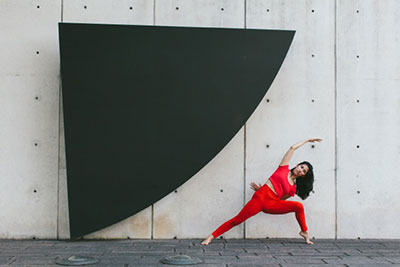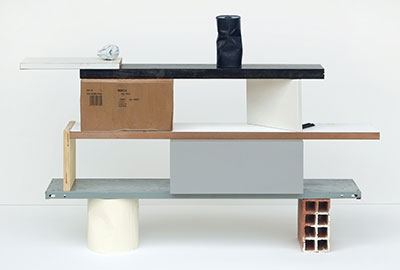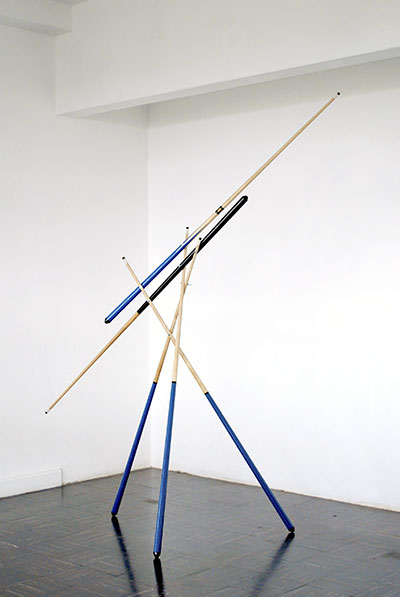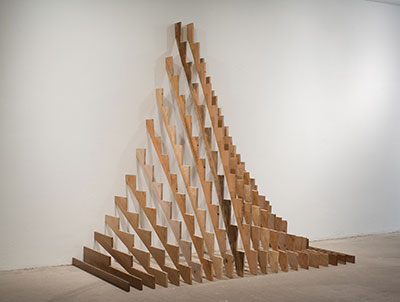Laura Gutierrez.
Photo by Lynn Lane.

Line is a concept never far from a dancer’s heart. Whether it’s the particular shape a dancer’s body takes or the pattern by which they traverse the stage, various meanings of “line” are deeply embedded in every dancer’s DNA.
Line also forms the unifying theme behind the group exhibition at Sicardi Gallery, Líneas de la mano, featuring work by Esvin Alarcón Lam, Ricardo Alcaide, Darío Escobar, Gianfranco Foschino, Juan Fernando Herrán, Harold Mendez, Gabriel de la Mora, Ronny Quevedo, and Ana Maria Tavares. The exhibition, curated by Sicardi Director Laura Wellen, runs through July 3.
In response to the show, Houston-based choreographer and dancer Laura Gutierrez will perform a program of new work titled Laura Elena Gutierrez (1987); 64 x 61 1/2 in.drawing from the themes in Líneas de la mano on May 26 & 27, 7pm at Sicardi Gallery.
“Many disciplines talk about line all the time,” says Wellen. “It’s a foundation, a starting point for understanding what is being represented or how an object is in conversation with its surroundings. Much of the dance I know and love is also about line as it connects to the motions of daily life.”

Settlements nº9
2015
Bronze and mixed media
116 x 21 x 82 cm
For Wellen, adding a movement component made sense. She explains, “I am really interested in bringing different voices into the conversation, to think across and between disciplines. The metaphor of line is an especially rich place to start. Lines are the building blocks for different kinds of creative work: texts, architectures, landscapes, movement. And the title of the exhibition references the body: lines of the hand. It made sense to me to have physical movement in the space, with the works. It’s a kind of connector between the ideas the artists are grappling with.”
Gutierrez sees line in large strokes as well. “Line is what takes dancers’ bodies from being seen as body parts moving to a living full image of supernatural art,” she says. “I’m really intrigued with showing audiences that the simplicity in line is powerful as it is. Choreographically, getting from point A to B is where all the fun happens for me, finding seamless transitions and literally a through line is crucial to a work.”
Wellen also sees how the shared concept of line can create a seamless connection between the arts. “I was reading about geometry, and how a line is defined by the function of connecting two points, but it also starts before those points and continues past them,” says Wellen. “And that, as a metaphor, is really beautiful to me. I am so eager to see how Laura is working with and representing line, with the body.”

Gutierrez, named one of “25 to watch” by Dance Magazine, has been exploring performing in museums and galleries for some time now. She performed Joan Jonas’ Mirror Check at Contemporary Arts Museum Houston, and in Tino Sehgal’s Instead of allowing something to rise up to your face dancing bruce and dan and other things at the Menil Collection. Most recently, she created Bare, a dance installation piece for Nicole Longnecker Gallery that included a riveting duet with Houston Ballet principal Connor Walsh. A frequent dancer with New York-based Jonah Bokaer, Gutierrez has also performed in museum settings in his work.
This time, she is taking her inspiration from the artists in Líneas de la mano. “I started off by simply being in the gallery space and just spending time witnessing the installation process, studying layouts of where the art is proposed to be hung in the space as well as studying images of each work of art that will be in the installation,” explains Gutierrez.

But it might be Gutierrez’s particular range of skills that best qualifies her for the Sicardi project. She moves with an exacting precision, a pristine clarity and a nuanced sense of when stillness is the best choice. Her razor sharp way of endowing space contains a potent power. The choreographer also welcomes the occasional role of being among the objects in a room. Raised in the lineage of American contemporary dance, Gutierrez represents the true millennial mover, fully able to take her post modern training and push it in her own direction. “I love challenges and a few have come up with this piece in that I will be performing alone for an extended amount of time and keeping the audience on the ride with me. I naturally lean towards expressing myself in a serious/aggressive tone, but I want to explore what it’s like to move more delicately and to be softer.”
Although dance doesn’t always directly use materials, it can evoke them qualitatively, which fits in nicely with Wellen’s ideas. “Many of the artists included share an interest in unusual materials, and all of them have a relationship to line and structure,” says Wellen. “They are in dialogue with the types of abstraction that we’ve been showing for 20 years. What makes the exhibition a bit different is that I’m thinking through how the formal qualities of line are also connected to our daily lives, to social content, to a politics of being in the world. In many of the works, there is also a re-thinking of the past, either of art historical references, or of social history. As a historian, I love the idea that line is relevant to that kind of re-thinking and re-working.”
The performance gives Gutierrez a chance to do some rethinking of her own along those same lines. “I am a female Latina choreographer and dancer. In Lineas de la Mano, only one out of the nine artists is a woman and Sicardi Gallery showcases work solely of Latino artists. It didn’t occur to me at the time I met with Laura Wellen, but I do fit into the very small pools of both of these molds being a female artist and Latina. For a while, I’ve battled with identifying with my Tejano/Mexican roots. I’ve never fully addressed that for myself, so this work is allowing me to skim the surface of that huge topic.”

Sicardi Gallery has hosted performance events in the past, including several events with Aperio. This marks their first dance performance event. “We get to engage with these different practices as they overlap,” says Wellen. “Ideally, the project brings a new audience to the gallery, and the gallery brings a new audience to Laura’s work. The arts don’t exist in a vacuum; it feels really right to have different kinds of work share the same space. This kind of programming always helps me to see things with new understanding.”
—NANCY WOZNY

